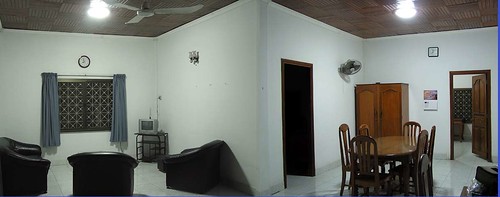Originally sent: 12 May 2005.
About this series.
I spotted my first rat on the way to work this morning which was the size of a small pony. It was headed in the direction of my house. Things bode ill.
I’ve just finished my first few weeks of work and it has been incredibly hard and exhausting. I’m the only native English speaker and despite the excellent language skills of my compatriots, I’m still not sure if people understand me or are just agreeing with me to save face. In the process, I swear that my ability to speak Khmer and English is rapidly declining. My position description is ill-defined and so I’ve spent most of the time meeting with people in the vain hope that they can tell me what I was hired for.
I seem to have been hired in lieu of getting cash from AusAid to pay for the projects that I should be working on (marketing income generating activities and the organisation generally). So at this stage I’ve got no funding to immediately implement anything at all. I’ve still got to meet with the chief accountant to see what I can squeeze out of the existing budget until the next round of funding in July. On the up side, everybody seems overwhelmingly pleased to have a Westerner to display at meetings and I do get the standard Cambodian two hour lunch break.
SCC, the organisation that I’m advising, is doing some fascinating work using Buddhist monks to implement HIV/AIDS prevention and care activities in Phnom Penh, Siem Riep (near Angkor Wat) and Battambang – so there will be monk stories aplenty in the coming months. I saw a monk smoking a cigar while talking on a mobile phone but didn’t think that it was prudent to take a photo because it was during a staff meeting with him.
To keep myself busy outside of work, I’ve bought myself a mountain bike for the regal sum of $35 so that I can immerse myself in the sheer lunacy of peak hour in Phnom Penh at speed. Rumour has it that you drive on the right hand side of the road but I can neither confirm nor deny this. Right of way is granted to whomever has the heaviest vehicle travelling at the greatest speed, regardless of signage, red lights or any other man-made barricades. Despite driving like the possessed, everyone acts courteously when you cut them off or run them down.
Speaking of barricades, if you have a wedding, you can erect the marquee for your hundred guests across the entire street in front of your house to further mar the flow of traffic. One was built on my way to work complete with separate catering tent, golden stupa, styrofoam Angkorian ruins and traditional Cambodian gamelan band; all scenically located within vomiting distance of the miasmal open sewer. Short of building the marquee directly over the top of the roiling sewer, there wouldn’t be a worse place in Phnom Penh to spend a few days in a tuxedo or wedding dress in the 40 degree heat.
Apart from the catering tent.

M and I moved into our house about two weeks ago. Our landlord lives next door and he is the nicest man in Phnom Penh, possibly because we pay him ten times the monthly Cambodian minimum wage for our house. When we arrived, he had already done about four of the tasks that we thought would be a real hassle with our substandard Khmer, like refilling the gas bottle and getting some spare keys cut. Another expat lives upstairs. The bathroom is a vision in lurid maroon. The whole house is tiled, so we can just hose the place out when the dust gets unbearable.
My two favourite beers at the moment are Love Beer (because let’s face it, who doesn’t? It even tastes like love) and Black Panther Stout (because The Man can’t keep the black beer down!). I’m also a bit partial to ABC Stout because their advertisements feature a Cambodian guy who looks like James Bond pimped out like Snoop Dogg. Confusingly the two top-selling beers here are Anchor and Angkor. Thanks to the infinite wisdom of Khmer pronunciation, “Anchor” rhymes with “ranch or”; and “Angkor” rhymes with “Anchor”. Angkor also means about five different things depending on how you pronounce “or” and thankfully none of them are mortally offensive when you slur drunkenly. You really can’t go too wrong either way, when it costs $9 for a whole slab.
In corruption news, the Cambodian Government just signed a 30 year agreement leasing Choung Ek – the Killing Fields Memorial and grimly popular genocide tourist attraction – to a Japanese company for $15,000 a year. The site is currently clearing a $20,000 per annum profit, not to mention that for better or worse, it is a vital piece of the Khmer peoples’ public heritage. My only guess here is that the Government knows that some sort of tourism apocalypse is headed for Cambodia (like a bird flu outbreak or a Commonwealth Games) because the tourism market has been growing at 100% per annum for the last 4 years. I smell a rat larger than a small pony.
